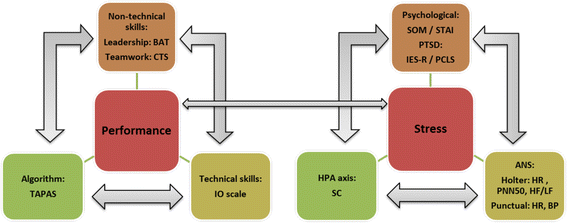Randomized controlled trial of multidisciplinary team stress and performance in immersive simulation for management of infant in shock: study protocol
- PMID: 27012938
- PMCID: PMC4807574
- DOI: 10.1186/s13049-016-0229-0
Randomized controlled trial of multidisciplinary team stress and performance in immersive simulation for management of infant in shock: study protocol
Abstract
Background: Human error and system failures continue to play a substantial role in adverse outcomes in healthcare. Simulation improves management of patients in critical condition, especially if it is undertaken by a multidisciplinary team. It covers technical skills (technical and therapeutic procedures) and non-technical skills, known as Crisis Resource Management. The relationship between stress and performance is theoretically described by the Yerkes-Dodson law as an inverted U-shaped curve. Performance is very low for a low level of stress and increases with an increased level of stress, up to a point, after which performance decreases and becomes severely impaired. The objectives of this randomized trial are to study the effect of stress on performance and the effect of repeated simulation sessions on performance and stress.
Methods: This study is a single-center, investigator-initiated randomized controlled trial including 48 participants distributed in 12 multidisciplinary teams. Each team is made up of 4 persons: an emergency physician, a resident, a nurse, and an ambulance driver who usually constitute a French Emergency Medical Service team. Six multidisciplinary teams are planning to undergo 9 simulation sessions over 1 year (experimental group), and 6 multidisciplinary teams are planning to undergo 3 simulation sessions over 1 year (control group). Evidence of the existence of stress will be assessed according to 3 criteria: biological, electrophysiological, and psychological stress. The impact of stress on overall team performance, technical procedure and teamwork will be evaluated. Participant self-assessment of the perceived impact of simulations on clinical practice will be collected. Detection of post-traumatic stress disorder will be performed by self-assessment questionnaire on the 7(th) day and after 1 month.
Discussion: We will concomitantly evaluate technical and non-technical performance, and the impact of stress on both. This is the first randomized trial studying repetition of simulation sessions and its impact on both clinical performance and stress, which is explored by objective and subjective assessments. We expect that stress decreases team performance and that repeated simulation will increase it. We expect no variation of stress parameters regardless of the level of performance.
Trial registration: ClinicalTrials.gov registration number NCT02424890.
Keywords: Multidisciplinary team; Performance; Randomized controlled trial; Simulation; Stress.
Figures

 Potential correlation
Potential correlation


Similar articles
-
Stress response in the daily lives of simulation repeaters. A randomized controlled trial assessing stress evolution over one year of repetitive immersive simulations.PLoS One. 2019 Jul 25;14(7):e0220111. doi: 10.1371/journal.pone.0220111. eCollection 2019. PLoS One. 2019. PMID: 31344077 Free PMC article. Clinical Trial.
-
Immersive simulation training at 6-week intervals for 1 year and multidisciplinary team performance scores: a randomized controlled trial of simulation training for life-threatening pediatric emergencies.Emergencias. 2019 Dic;31(6):391-398. Emergencias. 2019. PMID: 31777210 Clinical Trial. English, Spanish.
-
Performance Under Stress Conditions During Multidisciplinary Team Immersive Pediatric Simulations.Pediatr Crit Care Med. 2018 Jun;19(6):e270-e278. doi: 10.1097/PCC.0000000000001473. Pediatr Crit Care Med. 2018. PMID: 29432402 Clinical Trial.
-
[Training for real: simulation, team-training and communication to improve trauma management].Anasthesiol Intensivmed Notfallmed Schmerzther. 2010 Jun;45(6):408-15. doi: 10.1055/s-0030-1255348. Epub 2010 Jun 10. Anasthesiol Intensivmed Notfallmed Schmerzther. 2010. PMID: 20539968 Review. German.
-
Using simulation team training with human's factors components in obstetrics to improve patient outcome: A review of the literature.Eur J Obstet Gynecol Reprod Biol. 2021 May;260:159-165. doi: 10.1016/j.ejogrb.2021.03.015. Epub 2021 Mar 20. Eur J Obstet Gynecol Reprod Biol. 2021. PMID: 33784580 Review.
Cited by
-
Complex Decision Making in the Pediatric Catheterization Laboratory: Catheterizer, Know Thyself and the Data.Pediatr Cardiol. 2018 Oct;39(7):1281-1289. doi: 10.1007/s00246-018-1949-x. Epub 2018 Aug 13. Pediatr Cardiol. 2018. PMID: 30105465 Review.
-
Learning receptive awareness via neurofeedback in stressed healthcare providers: a prospective pilot investigation.BMC Res Notes. 2018 Sep 4;11(1):645. doi: 10.1186/s13104-018-3756-0. BMC Res Notes. 2018. PMID: 30180909 Free PMC article.
-
Development and Implementation of a Family Presence Facilitator Curriculum for Interprofessional Use in Pediatric Medical Resuscitations.MedEdPORTAL. 2024 Oct 8;20:11445. doi: 10.15766/mep_2374-8265.11445. eCollection 2024. MedEdPORTAL. 2024. PMID: 39381197 Free PMC article.
-
Stress response in the daily lives of simulation repeaters. A randomized controlled trial assessing stress evolution over one year of repetitive immersive simulations.PLoS One. 2019 Jul 25;14(7):e0220111. doi: 10.1371/journal.pone.0220111. eCollection 2019. PLoS One. 2019. PMID: 31344077 Free PMC article. Clinical Trial.
-
Decision-Making in the Catheter Laboratory: The Most Important Variable in Successful Outcomes.Pediatr Cardiol. 2020 Mar;41(3):459-468. doi: 10.1007/s00246-020-02295-1. Epub 2020 Mar 20. Pediatr Cardiol. 2020. PMID: 32198590 Review.
References
-
- Kleinman ME, Chameides L, Schexnayder SM, Samson RA, Fran Hazinski M, Atkins DL, et al. Pediatric advanced life support: 2010 American Heart Association. Guidelines for cardiopulmonary resuscitation and emergency cardiovascular care. Circulation. 2010;122(Suppl 3):876–908. doi: 10.1161/CIRCULATIONAHA.110.971101. - DOI - PubMed
-
- King HB, Battles J, Baker DP, Alonso A, Salas E, Webster J, Toomey L, Salisbury M. TeamSTEPPS™: Team Strategies and Tools to Enhance Performance and Patient Safety. In: Henriksen K, Battles JB, Keyes MA, Grady ML, editors. Advances in Patient Safety: New Directions and Alternative Approaches (Vol. 3: Performance and Tools). Rockville (MD): Agency for Healthcare Research and Quality (US); 2008. - PubMed
Publication types
MeSH terms
Associated data
LinkOut - more resources
Full Text Sources
Other Literature Sources
Medical

